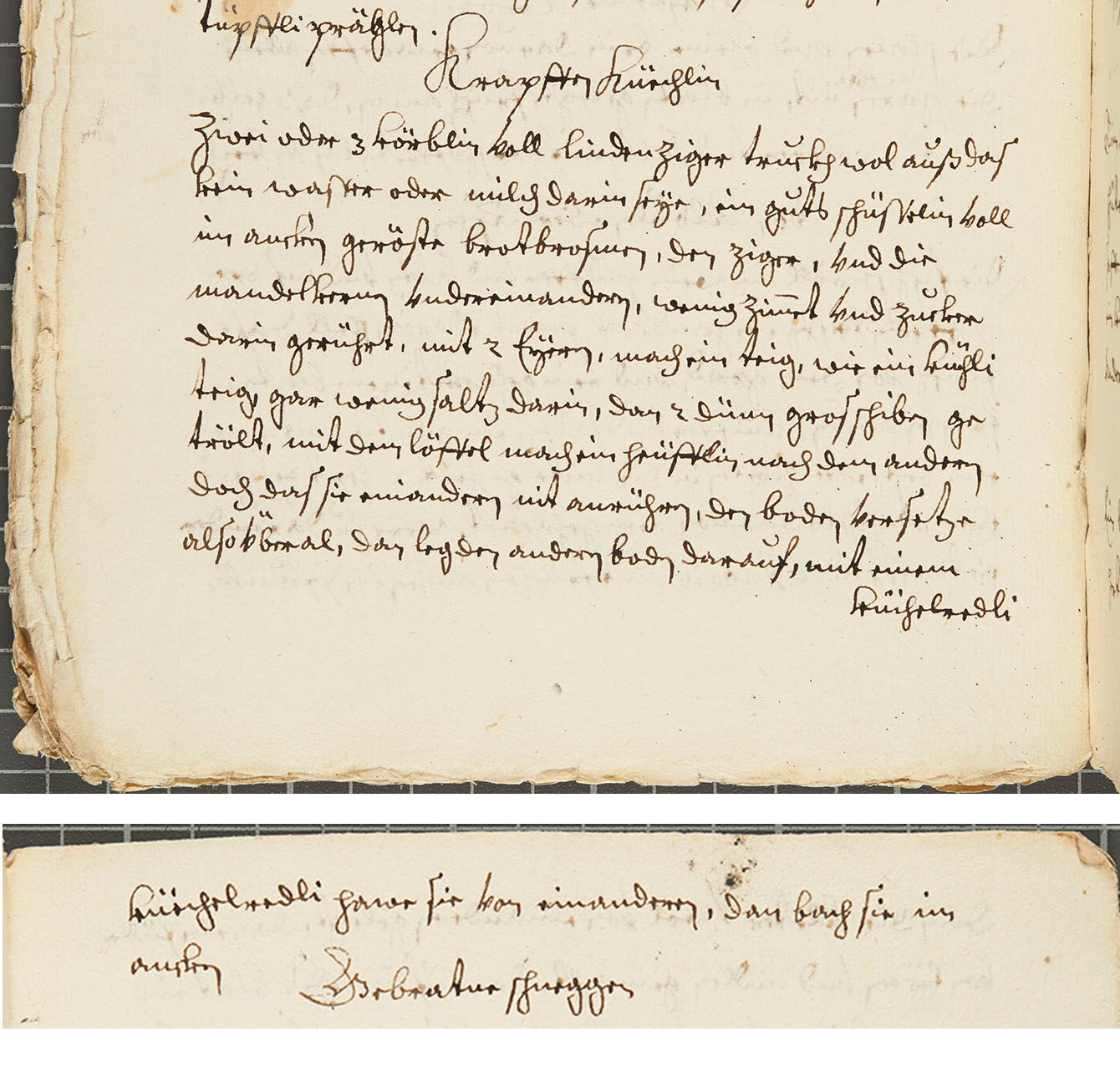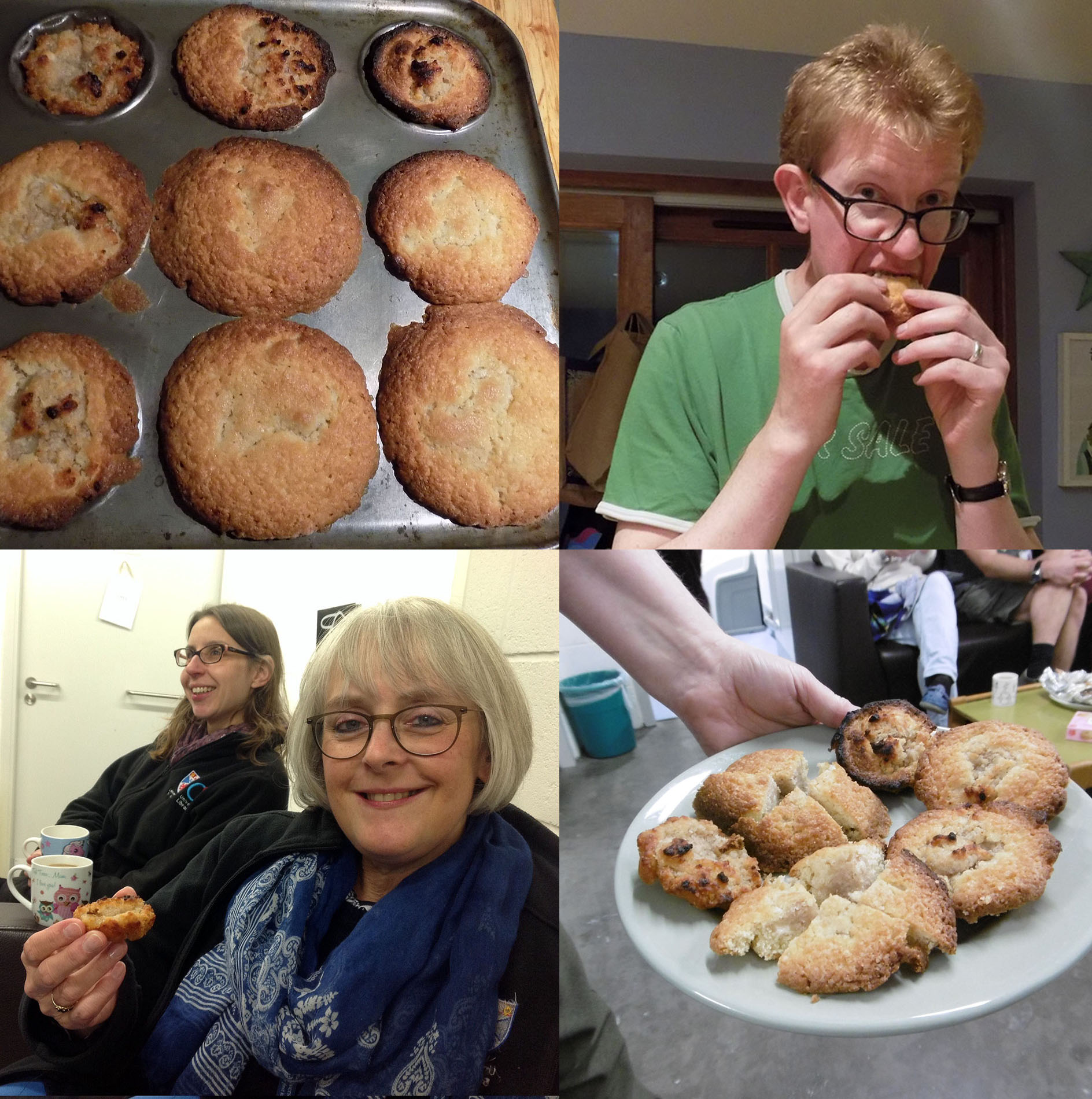Historical Cooking: Week 2 – Milk Soup and Kropffen Cakes
This is the second post in the Special Collections mini-series on our Swiss/German Renaissance cookery book (ms38990), and our first attempt at a recipe. Maia Sheridan was this week’s chef.
We tried two recipes this week.
Ein guten milch supen zu Machen – to make a good milk soup
Nimm ganzn milch, nimm 4 oder 5 eyer Nach dem du ein milch supenn haben wiltdt grosse oder klein, das gelben von 4 eyeren gekloffet fein wohl vndereinander darnach thueβ in ein pfannen wohl geruendt, biβ sie erwallet ist, dan thue ein guot stuckh zucker darin, shneidt in im blatten ein, so sie wol erwallen iso richt βin über daβ brodt an.

Take whole milk, take 4 or 5 eggs. Then, depending on whether you want a large or small milk soup, beat in the yolk of four eggs well, and then put this in a pan well [grereundt], until it is [ready], then add a good amount of sugar, pour in a bowl, when it is well [ready] serve it on bread.

The first recipe was called milk soup, a common Eastern European dish which is usually savoury with flour, rice or noodles added to the milk, and often also whatever vegetables and meat were available. However this turned out to be a sweet version, basically a custard, which was quite pleasant until the instructions were followed to serve it on bread – not nice! Hannah Glasse in The Art of Cookery Made Plain and Easy (1747) has a later and more successful version where the bread/custard mix go back into the oven to soften and that comes out as bread and butter pudding.

Kropffen küechlin – [Kropffen] cakes
Zwei oder 3 körblin voll linden ziger truckh wol auβ das kein wasser oder milch darin seye, ein gutβ shüsslein voll im ancken geröste brotbrosinen, den ziger, vnd die mandelkernen vndereinanderen, wenig zimet vnd zucker darin gerühret, mit 2 eyeren, mach ein teig, wie ein kuchli teig, gar wenig saltz darin, dan 2 dünnen gros shiben getrölt, mit den löffel mach ein heüffelin nach den anderen doch das sie einanderen nit anrühren den balen versetze also vberal, dan leg die anderen balen darauf, mit einem Küchelredli hawe sie von einanderen, dan bach sie im ancken.

Press out two or 3 baskets of [soft goat’s cheese], so no water or milk remains in them, a good bowl of breadcrumbs fried in butter, and mix together with the cheese and almonds, add a little cinnamon and sugar, make a dough with 2 eggs, like a cake dough, add a little salt, then take two large thin sheets, using a spoon make small heaps, and so that they are not touching spread the balls out, then put on the other balls, using a kitchen wheel separate them from each other, then bake them in butter.

There were two attempts at the second recipe, Kropffen cakes. This is one of the few recipes in the book to include cheese, in this case goat’s cheese. It sounded like it might be interesting, mixing the cheese with cinnamon and sugar, and crunchy breadcrumbs. The instructions were quite vague, particularly as to quantities and technique. For the first try the goat’s cheese mix was made up and then eggs were added to make this into dough. This produced hard gritty little rock cakes. That didn’t seem quite right.

There’s an Italian kind of custard doughnut called krapfen, so thinking this could be something similar, Maia made another attempt. This time the cheese mixture was used as a filling for small sponge cakes; the recipe said cake dough rather than bread dough.

A normal sponge mix was made, spooned it into the bun tray, a hole made in the middle for the cheese mixture. Some were covered with more dough (these ones spread out too much), and others left uncovered.

This sort of resembled the adding balls to other balls instructions in the recipe. Baked at 180’C for about 15 minutes, they turned out to be very edible, particularly hot straight from the oven. They were tried out on colleagues with some success!

Some of the words in the recipes were ambiguous and so another version might be created using soft cream cheese instead of the sharper goat’s cheese, and raisins instead of fried breadcrumbs. Although perhaps we don’t need to experiment further – the comment from one taster was ‘Absolutely delicious’ and he particularly liked the combination of sweet and savoury, rather like the recent fashion for salted caramel and other sweet but salty dishes.
Let us know if you try it; this recipe is a winner!
Maia Sheridan
Manuscripts Archivist
The complete manuscript is available for viewing on our Digital Collections Portal – with a transcription and translation to follow soon!
I adore historical recipes and really tempted to try it out. Good series.
Thanks for your comment - let us know if you try any of the recipes!
[…] Andrews, Special Collections which the Special Collections team then ‘re-enacted’ see: https://standrewsrarebooks.wordpress.com/2016/10/20/historical-cooking-week-2-milk-soup-and-kropffen… A different attempt at some ‘archival’ cookery by Special Collections, St. Andrews see […]